Note to Visitors:
Permission for placement of this EarthCache was granted by the director of Stafford County Parks, Recreation and Community Facilities. The Armed Services Memorial is free and open to the public during daylight hours. Ample parking can be found in the adjacent lot. Occasionally, impromptu weddings occur on the site due to the proximity of the local Courthouse. Please treat such occasions with courtesy. As with all such memorials, the location is a place of solemn reflection. It is asked that everyone be respectful of the memorial itself and to any other visitors that might be at the site. Please enjoy both the spirit of the memorial and its displays of geology.
As an EarthCache, no container is located at the coordinates. Instead, you will have to learn some geology and make some observations about the surroundings. TO CLAIM CREDIT FOR THE CACHE YOU MUST EITHER E-MAIL OR MESSSAGE ANSWERS TO ALL 4 QUESTIONS PRESENTED BELOW. Do not put any answers or spoiler pictures in your logs. Logs received without answers sent via e-mail/messenger within a week will be deleted. While not required, a picture of you at your favorite part of the memorial will go a long way towards compensating for wrong answers.
The Granite Umbrella:
What actually constitutes “granite” in some ways falls in the eyes of the beholder. To an amateur geologist (or typical earth cacher), granite consists of a coarse-grained, light-colored, igneous rock composed mainly of feldspars and quartz; it also contains minor amounts of mica and amphibole minerals.
A petrologist views granite as a plutonic rock (igneous rocks that solidified from a melt at great depth) in which quartz makes up between 10 and 50 percent of the felsic components (silicate minerals which have a lower percentage of heavier elements). Alkali feldspar (those containing Sodium or Potassium) accounts for 65 to 90 percent of the total feldspar content. Many rocks identified as "granite" using the introductory course definition will not be called "granite" by a petrologist - they might instead be referred to as alkali granites, granodiorites, pegmatites, or aplites.
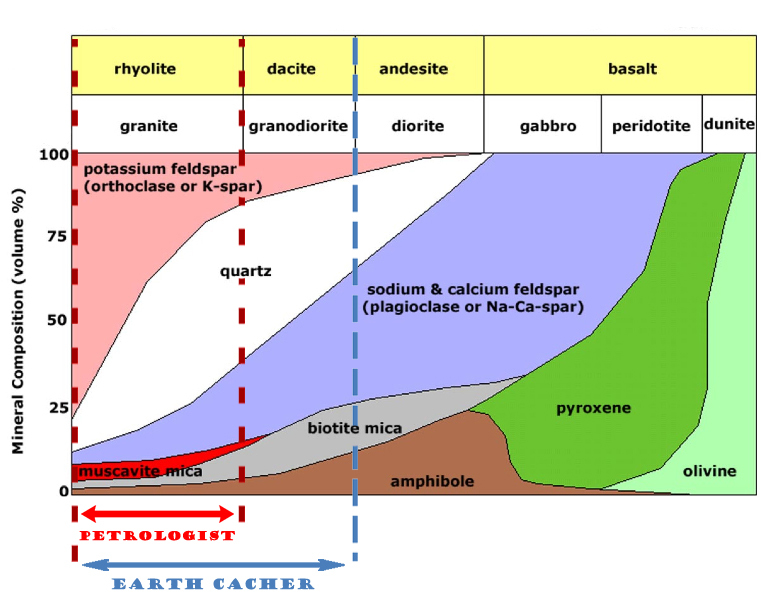
FIGURE 1
Figure 1 above shows the difference in composition between a “casual” definition of granite and that applied by a petrologist.
To those making and selling granite for commercial usage the definition is much looser. Commercial granite is a rock with visible grains which is harder than marble. Under these criteria many other igneous rocks will be classified as "granite”.[1] Applying this definition, gabbro, basalt, pegmatite, schist, gneiss, syenite, monzonite, anorthosite, granodiorite, diabase, diorite, and many other rocks would be considered "granite."[2] Basically every composition contained in the first figure would qualify as commercial granite.
Igneous Rock:
Whatever definition of granite is applied, granite is always an igneous rock. Igneous rocks (from the Latin word for fire) form when hot, molten rock crystallizes and solidifies. The melt originates deep within the Earth near active plate boundaries or hot spots, then rises toward the surface. Igneous rocks are divided into two groups, intrusive or extrusive, depending upon where the molten rock solidifies.[3]
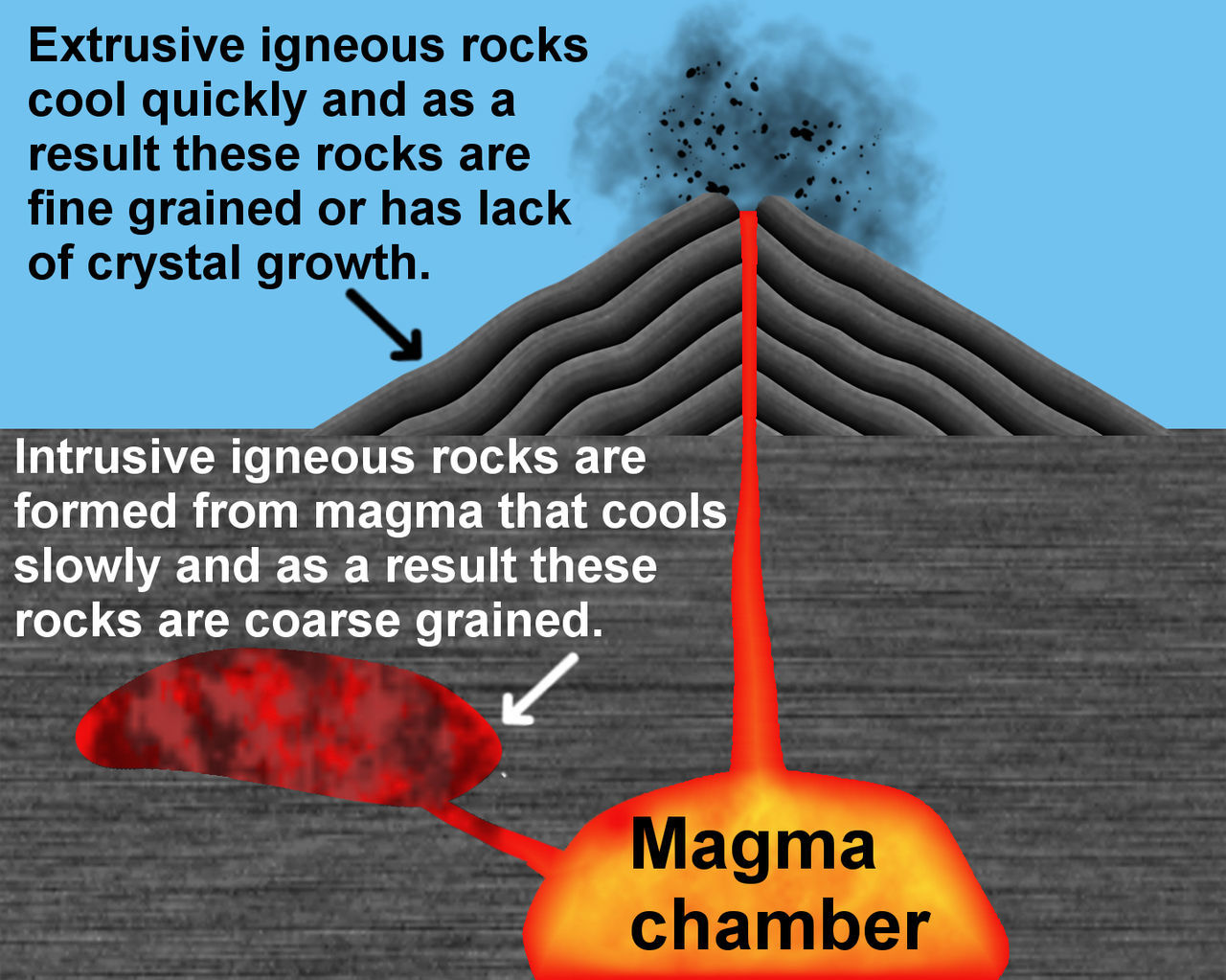
FIGURE 2
Figure 2 shows the hot molten magma deep within the earth's crust following one of two paths. If the magma stays underground and slowly cools as a result of contact with cooler surrounding rocks, intrusive igneous rocks are formed. If the magma is expelled from the underground, as in a volcanic eruption, and rapidly cools, extrusive igneous rocks are produced.
Magma trapped below the Earth’s surface cools very slowly over many thousands or millions of years until it solidifies. Slow cooling means the individual mineral grains have a very long time to grow to a relatively large size. For this reason, intrusive rocks have a coarse-grained texture. When magma erupts on the surface it is called lava. Lava cools and solidifies almost instantly when it is exposed to the relatively cool temperature of the atmosphere. Quick cooling means that mineral crystals don't have much time to grow. For this reason, extrusive rocks have a very fine-grained or even glassy texture.
Mineral Content:
The exact composition of granite depends on whose definition is being used. For the petrologist granite is a light-colored rock. Commercial granite can range from light colored to jet black. This variance in color is due to the variance in minerals present in the rock.
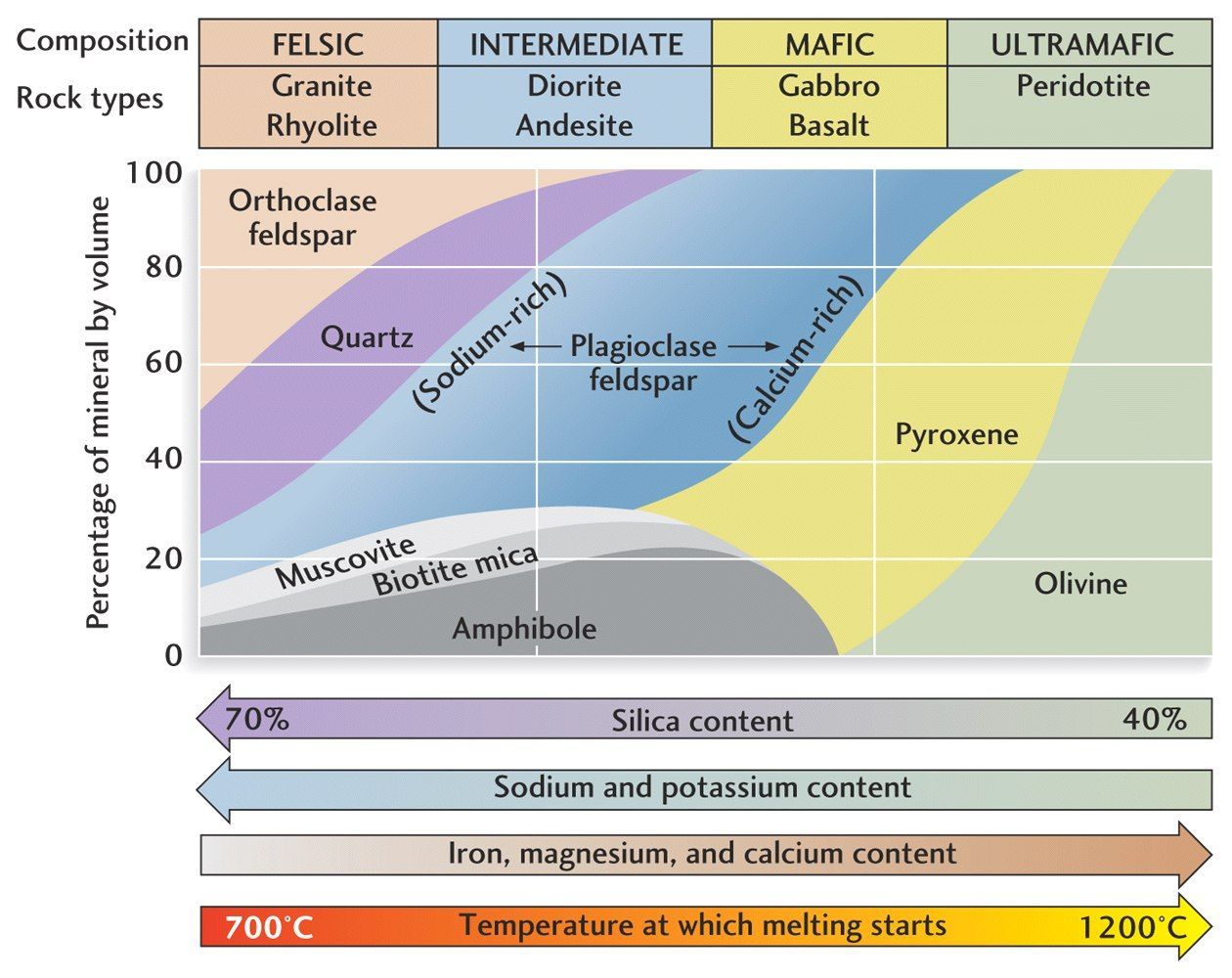
FIGURE 3
On the far left of Figure 3 above reside the petrologist’s granites. They are referred to as “felsic” in composition. These are igneous rocks that are relatively rich in elements that form feldspar (aluminum silicates with either potassium, sodium, calcium) and quartz (silicon dioxide). Going to the right in the figure shows a transition to rocks with increased concentrations of iron, magnesium and calcium. At the extreme these rocks are referred to as “mafic” (dark-colored, mainly ferromagnesian minerals). As commercial granites expand past the area geologists would consider “true” granite they can encompass a broader range of mafic and ultramafic compositions.
Figure 4 below mirrors (literally) Figure 3 above. Mineral order has been flipped from top to bottom, but the left and right transition from felsic to ultramafic remains unchanged. Examples of rocks that fall into the four different compositions (felsic, intermediate, mafic and ultramafic) are provided under the chart. The darkening of the rocks can be seen going from left to right. It should be noted that because both intrusive and extrusive igneous rocks differ in only how quickly they have cooled, both types darken as the transition from felsic to ultramafic composition occurs.
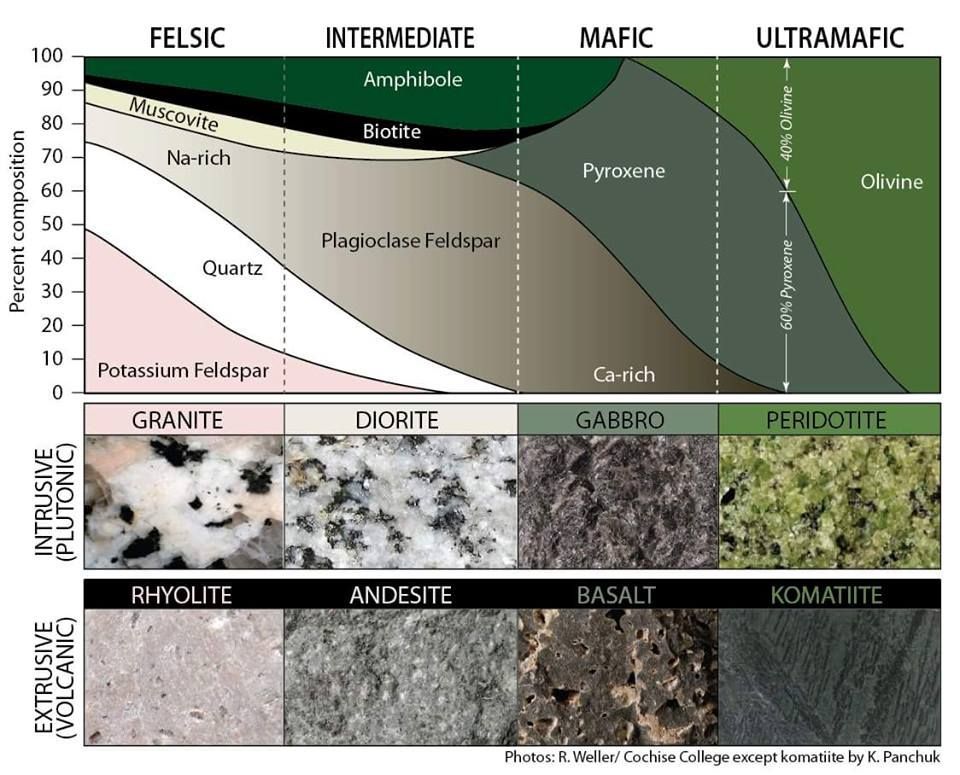
FIGURE 4
In some ways it is easier to visualize the difference in intrusive and extrusive by putting the graphs above in a 3D configuration as seen in Figure 5. The X and Y axis remain the same as before. The new Z-axis going back into the plane of the paper represents crystal size. Up front are rocks with a Phaneritic texture (possessing crystals large enough to be distinguished with the unaided eye). Intrusive rocks have a phaneritic texture because they cool slower, and give crystals a chance to slowly form and grow. Aphanitic texture (so fine-grained that component mineral crystals are not detectable by the unaided eye) is formed from rapid cooling.[4] Extrusive rocks produce aphanitic textures. Note the crystal sizes previously seen in the samples in Figure 4.
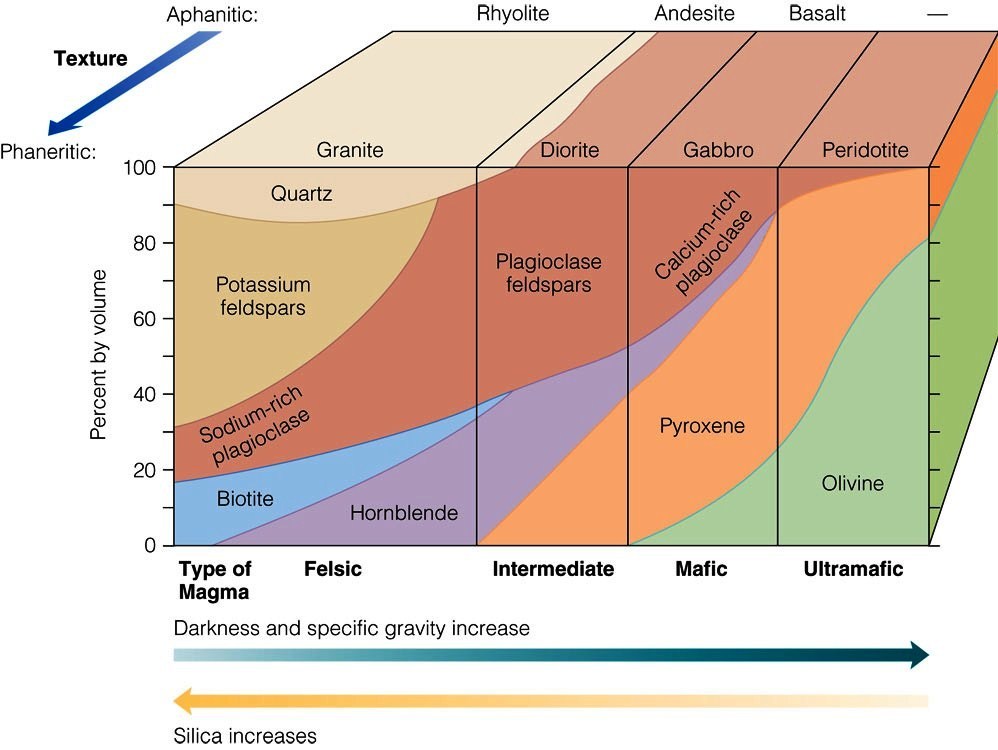
FIGURE 5
Memorial Rocks:
The Stafford Armed Services Memorial utilizes 4 kinds of Granite.[5] The 4 granites present include:
Georgia Blue Granite
Georgia Blue/Gray Granite
American Black Granite
Jet Black Granite
The two “Georgia” granites came from the Elberton Batholith. A batholith is a large body of igneous rock formed beneath the Earth’s surface by the intrusion and solidification of magma. It is commonly composed of coarse-grained rocks (e.g., granite or granodiorite) with a surface exposure of 100 square km (40 square miles) or larger. The Elberton Batholith can be seen circled in red in the Figure 6.[6]
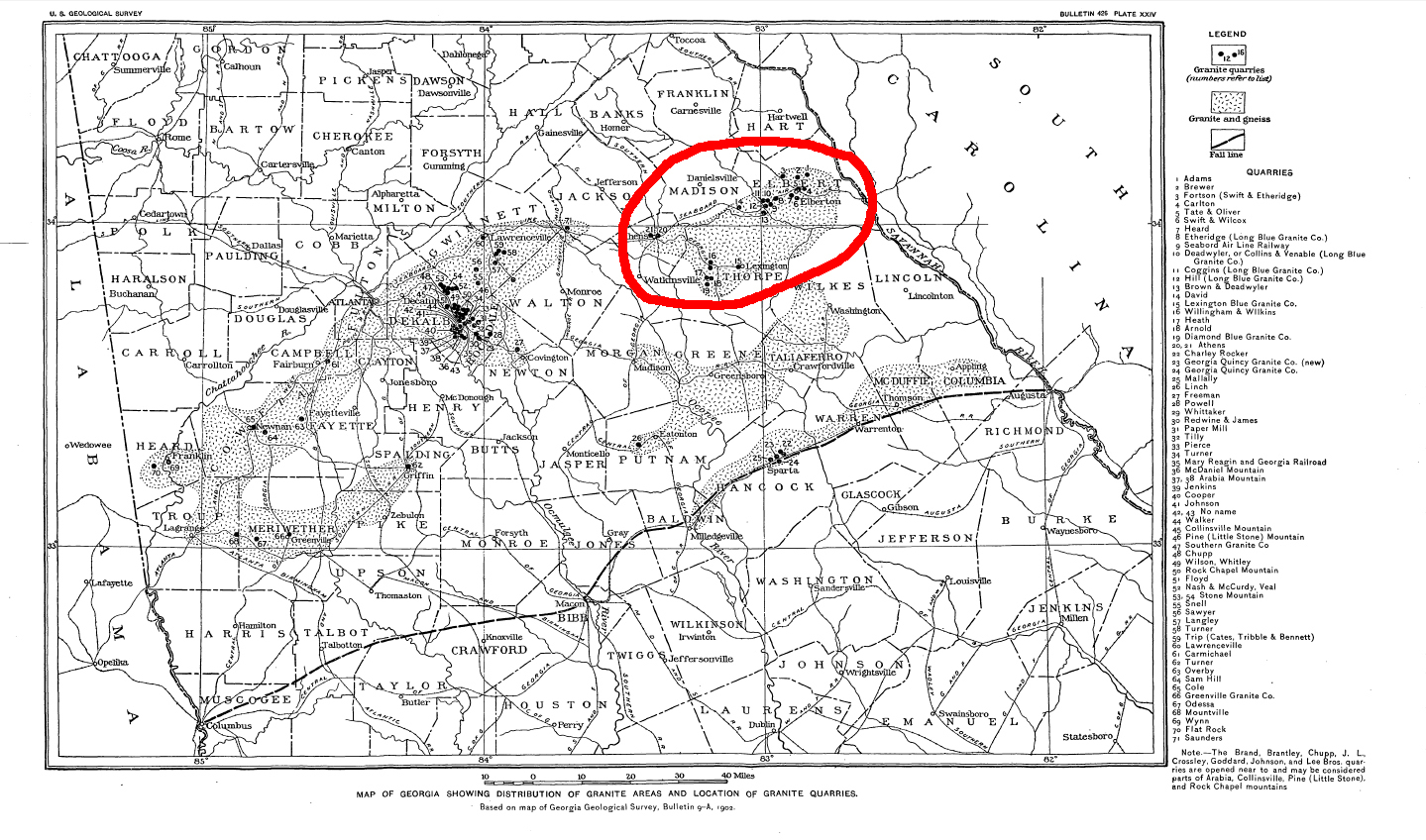
FIGURE 6
Analysis of Georgian granites shows very even chemical composition with approximately 70% silica, 17% Alumina, and 9% Sodium and Potassium alkalis. In terms of composition these granites are made up of mixtures of the essential minerals feldspar, quartz, and biotite, with varying proportions of muscovite (pearly colored mica) intimately associated with the biotite (black mica).[6] Images of both muscovite and biotite are provide in Figure 7.
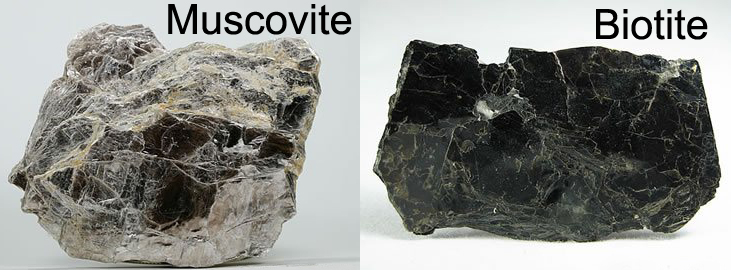
FIGURE 7
Pegmatite dikes of slight thickness cut the Georgia blue-gray granite.[6] Pegmatites consists of igneous rocks that form during the final stage of a magma’s crystallization which contain exceptionally large crystals. Most pegmatites have a composition that is similar to granite with abundant quartz, feldspar, and mica. An inclusion of a pegmatite vein contained within the Georgia Blue/Gray Granite is visible along the west side of the memorial wall. The location of this vein is seen in Figure 8 (along with a sample of pegmatite). This section of wall starts right after the flag pole and benches.
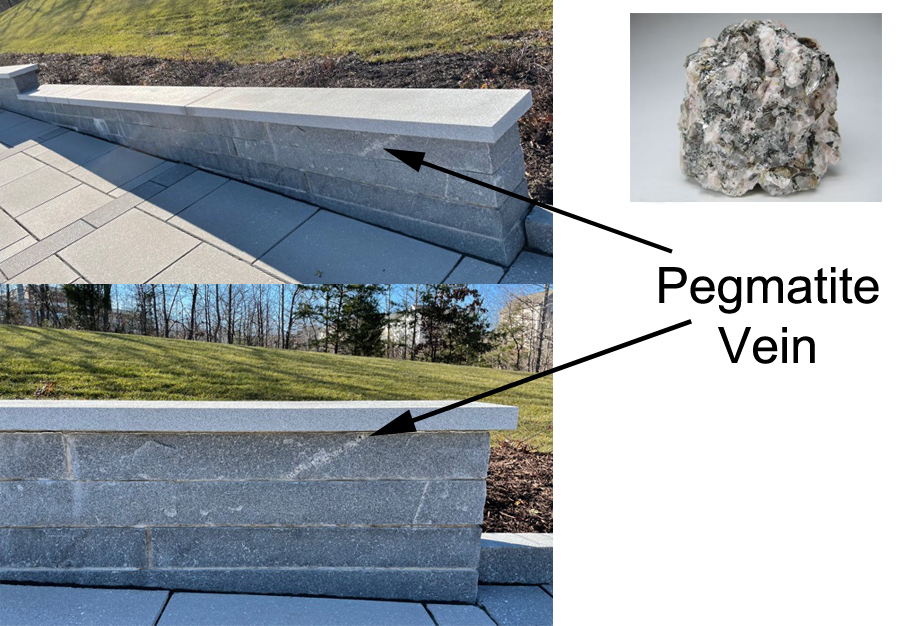
FIGURE 8
QUESTION 1: Does this vein contain more of either Muscovite or Biotite, or are they evenly distributed?
It is difficult to distinguish, outside of difference in shading, between the Georgia Blue/Gray and Gray granites. The light-gray granite does not differ essentially in mineral composition from the darker blue/gray granite. The difference is essentially one of color, the biotite being distributed at greater intervals and in somewhat shorter aggregated shreds in the light-gray granite.[6]
QUESTION 2: Which appears more Phaneritic: The Blue/Gray stone making up the wall or the Gray granite capping the wall? See Figure 4 & 5 for a refresher.
The “war markers” leading up to the globe and mural wall are made from American Black Granite. The term "black granite" includes a variety of rocks with three mineralogic features in common. They contain comparatively little or no quartz, their feldspar belongs entirely or almost entirely to the series which contains both soda (Sodium) and lime (Calcium), and they contain a considerable amount of one of the pyroxenes, or hornblende or biotite, and magnetite, which accounts for the general darkness of their shade or their greenish color.[7]
A unique attribute of American Black granite is its linear veining. While the previous granites were quarried in Georgia, American Black does not originate from the same location. The most well-known quarry for this variant is located in Elverson, Pennsylvania. The black granite from PA is really a diabase (an intrusive igneous rock that has a composition similar to basalt and gabbro).[8 ] The difference between basalt, diabase, and gabbro is in their grain size - which was determined by their cooling rates. Diabase has a crystal size between that of basalt and gabbro (see Figure 5 for context).
Finally, the granite utilized in the globe, its pentagonal base, and the mural wall is Jet Black Granite. Characterization of “Black Granites” is further broken down by grain sizes. A first classification based on the color of the rock and grain size was made by Bossi and Campal (1991) and continued by Bossi and Schipilov (2007). They determined that the Absolute Black is aphanitic with a mean grain size between 0.1 and 0.2 mm. Fine Black is a fine-grained variety with a grain size between 0.3 and 0.5 mm. Normal Black (known as Oriental) has a grain size between 0.6 and 0.8 mm and the Coarse Black is coarser than 1 mm.[9] No indication of where the Jet Black granite for the memorial was sourced from could be found. There is no Jet Black granite quarried in the USA for the monument market. This varietal of granite is often imported from other countries (the most common being India, China and South Africa).
QUESTION 3: Of the four categories outlined, where would you place both the American Black and Jet Black granite found at the memorial? For reference, the typical lines used to print the numbers on a credit card are roughly 1 mm thick.
Absolute Black (Grain size = 0.1 and 0.2 mm)
Fine Black (Grain size = 0.3 and 0.5 mm)
Normal Black (Grain size = 0.6 and 0.8 mm)
Coarse Black (Grain size > 1 mm or ~1/32”)
QUESTION 4: List the four granites at the memorial in order of most to least Mafic. See Figure 4 for a refresher

References:
1. https://geology.com/rocks/granite.shtml
2. Fakhry, Mahmoud & Abd El-Kader, Mahmoud & Al-Abyad, Mohanad & El-Shobaki, Mahmoud & Shouaib, Ahmed. (2017). Granite & Marble Industry in Egypt. https://doi.org/10.13140/RG.2.2.12642.12486
3. https://www.usgs.gov/faqs/what-are-igneous-rocks?qt-news_science_products=0#qt-news_science_products
4. http://www.geologyin.com/2014/09/what-is-difference-between-phaneritic.html
5. Elberton Graniteer Fall 2017, Vol.61, Number 3, p. 25.
https://egaonline.com/sites/default/files/pictures/WAR%20MEMORIALS%20BOOK%201.pdf
6. Thomas Leonard Watson, Granites of the Southeastern United States, Department of the Interior, United States Geological Survey, Bulletin 426, 1910.
7. T. Nelson Dale, The Commercial Granites of New England, Department of the Interior, United States Geological Survey, Bulletin 738, 1923.
8. F. Bascom & G. W. Stose, Geology and Mineral Resources of the Honeybrook and Phoenixville Quadrangles, Pennsylvania, Department of the Interior, United States Geological Survey, Bulletin 891, 1938.
9. Manuela Morales Demarco et. al., “Black dimensional stones: geology, technical properties and deposit characterization of the dolerites from Uruguay”, Environmental Earth Sciences, 63, p. 1879–1909, 2011.